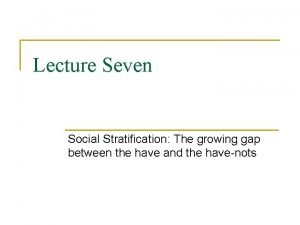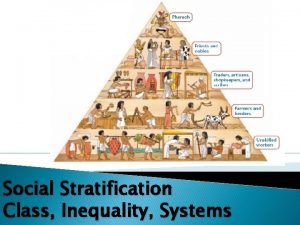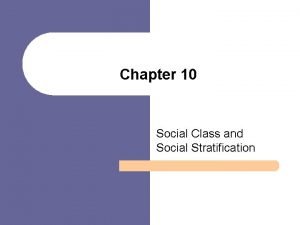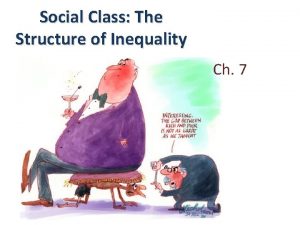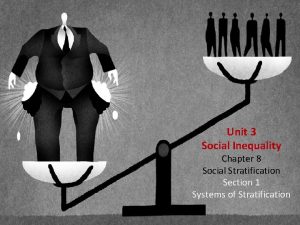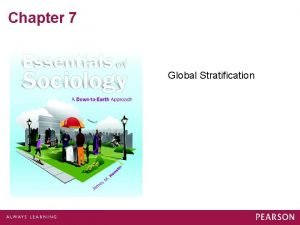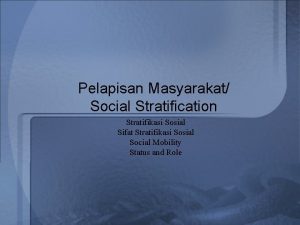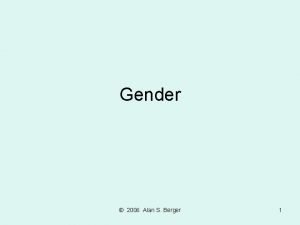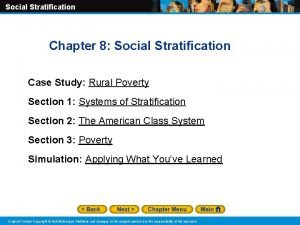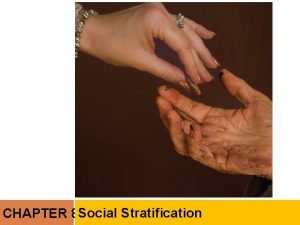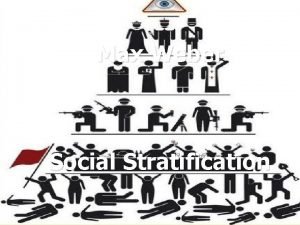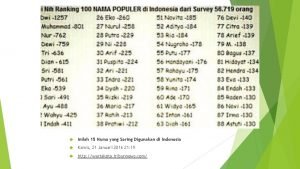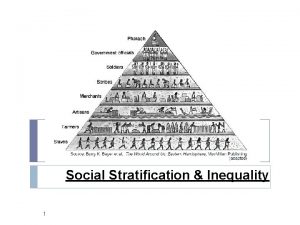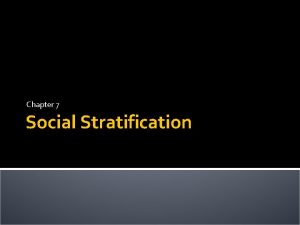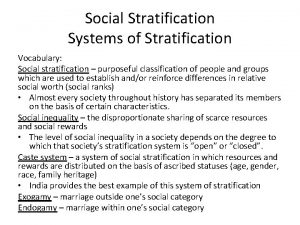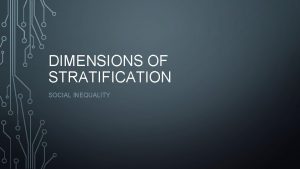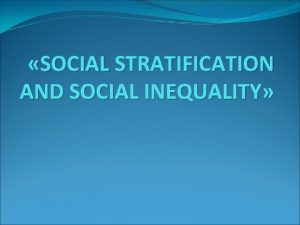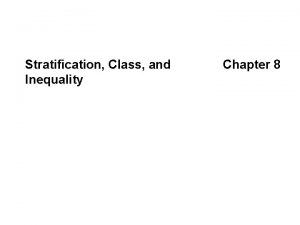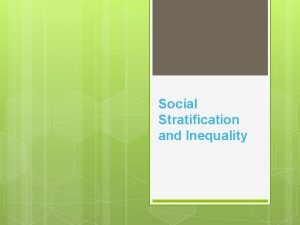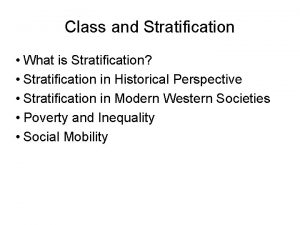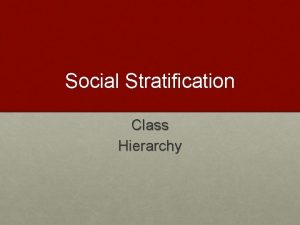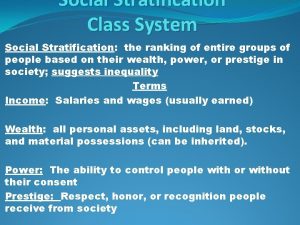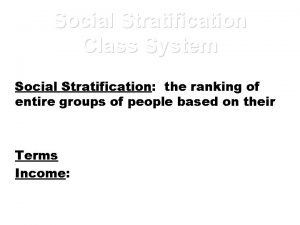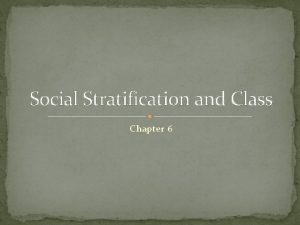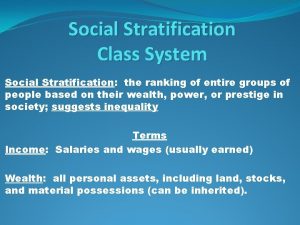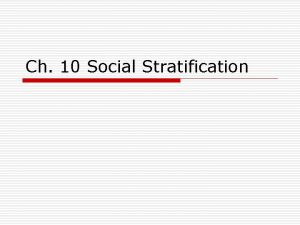Social Stratification Class Inequality Systems What is Stratification

























- Slides: 25

Social Stratification Class, Inequality, Systems

What is Stratification? �A system society uses to rank its citizens into a hierarchy (rank) of classes ◦ Exist in every human society and culture ◦ Unequal distribution of society’s rewards � Examples ◦ ◦ Estate System (Feudal Europe) Caste System (India) Class System (US, Europe) Slavery

Historical Stratification Systems � Slavery – one person owns another person ◦ Has appeared in countless cultures throughout human history ◦ Causes are various – Debt, crime, prisoners of war, racial superiority � American slavery was unique ◦ Equal male to female ratio ◦ Longer lives ◦ Slaves reproduced and children were slaves ◦ In other societies, slavery was not hereditary or permanent in most cases. � Slavery still exists in parts of the world (sex or debt are most common causes)

MODERN SLAVERY Where are most of today’s slave populations? Why might these areas be likely to have slavery?

Modern Stratification Systems � Class System – social status is achieved (earned) by merit, exploits, education, etc ◦ Social mobility (ability to move up or down in rank) is a characteristic ◦ A person’s class may change throughout his or her life (Intragenerational) ◦ Children may advance to a higher class than their parents (Intergenerational) � The American Dream allegedly reflects this concept ◦ What is the American Dream? ◦ Do you believe it still exists? ◦ Did it ever exist?

Why Stratification? � More complex societies produce more stratification ◦ Hunter-Gatherers had little stratification: No need! ◦ Agriculture led to Job Specialization �Not all jobs are valued the same �This led to inequality �Industry created a greater divide between haves and have-nots �Skilled workers created a “middle class” between the haves and have-nots ◦ Modern development and economies have created Global Stratification �Global Inequality - Rich countries, developing countries, and poor countries

How does Stratification Affect Us? �Income or wealth impacts ◦ The neighborhood you live in ◦ The schools you go to ◦ The cars you drive/ride in ◦ Your clothes ◦ Your toys

Sociopoly – Who Will Win? ? ? � Today you will be divided into groups. � You will be given a number within each group. � That number will reflect which “Class” you get to play as. � Each player will be given a sheet with the rules explained on it. � That sheet will also be your score sheet. � Record each turn’s actions.

Stratification in the US �Socioeconomic Status (SES) determines a person’s class in the US ◦ Uses education, Occupation, and Income to determine class �This system is not perfect because each category can be misleading

Education �Classifying someone by education can be tricky because ◦ Schools are not uniform, some are better/worse ◦ Not everyone has quality access ◦ Poor vs Wealthy communities � Drop out rate? � Prepared for college? � Afford college?

Occupation � Occupational prestige varies ◦ Doctors, judges, lawyers, CEOs ◦ Waitress, Mechanic, Maid, Cashier, Janitor � Prestigious jobs are also harder to hold and acquire � We assume the job a person does is the one they want or are best suited for – not always true � We are biased for/against certain jobs

Income �Least reliable factor in SES �Income can vary according to ◦ Geographic location ◦ Size of company ◦ Education level ◦ Work experience �Cost of living differences ◦ Memphis vs Gulfport ◦ Urban vs Rural

Stratification in the United States � In the United States we generally define 6 separate classes 1. Upper Class (Old Money) 2. New Money 3. Middle Class 4. Working Class 5. Working Poor 6. Poor (Poverty Level)

Upper Class (Old Money) � Roughly 1% of the US population � Inherited wealth from previous generations � Famous names: Kennedy, Rockefeller, Vanderbilt, etc � Common Characteristics ◦ Attended high end schools and colleges ◦ Live lavish lifestyles ◦ Don’t rely on salaries for income

Upper Class (New Money) � Roughly 15% of the population � Includes people who recently made their fortunes � Examples: Professional athletes (Le. Bron James), actors (Brad Pitt), celebrities (Jay-Z), CEOs (Bill Gates), entrepreneurs (Mark Cuban) � This group has earned their money and live very different lifestyles from other classes

Middle Class � Roughly 34% of the US population � This class typically earns their money by working professional jobs � Common Characteristics ◦ Attended/Graduated from College ◦ Live in suburbs or “nice” neighborhoods ◦ Rarely wear uniforms – “White Collar”

Working Class � Roughly 30% of the US population � This class often works hourly or technical jobs � Common Characteristics ◦ Attended college or vocational schools ◦ Work a variety of jobs or trades ◦ Union members ◦ “Blue Collar” workers – likely to wear a uniform

Working Poor/Poverty Level � These last two classes comprise roughly 20% of the US population � These classes can be very transitional as employment status, government benefits/aid, and region can impact class � Common Characteristics ◦ Low levels of education ◦ Minimum wage Hourly employment – (last hired, first fired) ◦ Very little job security ◦ Likely to receive some form(s) of government aid (Welfare)

Poverty in America � Who is poor? ◦ ~66% of poor people are white ◦ ~25% of poor people are black ◦ ~50% of female headed households are poor ◦ (2005) 16% of children younger than 18 years old were poor � Where is poverty? ◦ Rural South and Inner Cities �Lack of manufacturing jobs �Lower education levels

What causes this? What can we do?

Effects of Poverty �People living in poverty live shorter lives and are more likely to suffer from health problems ◦ Lack of quality education ◦ Poor diet, little exercise ◦ More likely to lack health insurance and don’t get regular check ups ◦ Chronic high levels of stress ◦ No jobs with vacation time ◦ Higher rates of divorce and substance abuse (stress)

Minimum Wage? Food for Thought

Culture of Poverty �Oscar Lewis coined the term “Culture of Poverty” poverty can be self-perpetuating ◦ Poor parents never learned how to better their lives and fail to pass those lessons on ◦ Poverty breeds poverty ◦ Continuous cycle ◦ How can we break the cycle?


Global Stratification �The world is stratified just like individual societies �We divide the world into 3 categories ◦ Most Industrialized (1 st World) – Western and very developed parts of the world ◦ Industrializing (2 nd World) – Former Soviet Union, China**, and developing areas ◦ Least Industrialized (3 rd World) – about half the world and 70% of the world’s population
 Social stratification vs social inequality
Social stratification vs social inequality Social classes in social stratification
Social classes in social stratification Weber class
Weber class Systems of social stratification
Systems of social stratification Class and inequality
Class and inequality Write a compound inequality as an absolute value inequality
Write a compound inequality as an absolute value inequality Open and closed stratification systems
Open and closed stratification systems How do elites maintain stratification
How do elites maintain stratification The societal tendency toward class stratification
The societal tendency toward class stratification The danger of a naive working class animal farm
The danger of a naive working class animal farm Mixed social stratification
Mixed social stratification Gender stratified
Gender stratified Social stratification slideshare
Social stratification slideshare Social inequalities examples
Social inequalities examples Chapter 8 social stratification
Chapter 8 social stratification Dimensions of stratification
Dimensions of stratification Max weber social stratification
Max weber social stratification Max weber social class
Max weber social class Social stratification in sociology
Social stratification in sociology Pelapisan sosial
Pelapisan sosial Mixed social stratification
Mixed social stratification Chapter 9 social stratification
Chapter 9 social stratification Chapter 8 social stratification
Chapter 8 social stratification Status weber
Status weber Functionalism social inequality
Functionalism social inequality Social inequality definition
Social inequality definition
